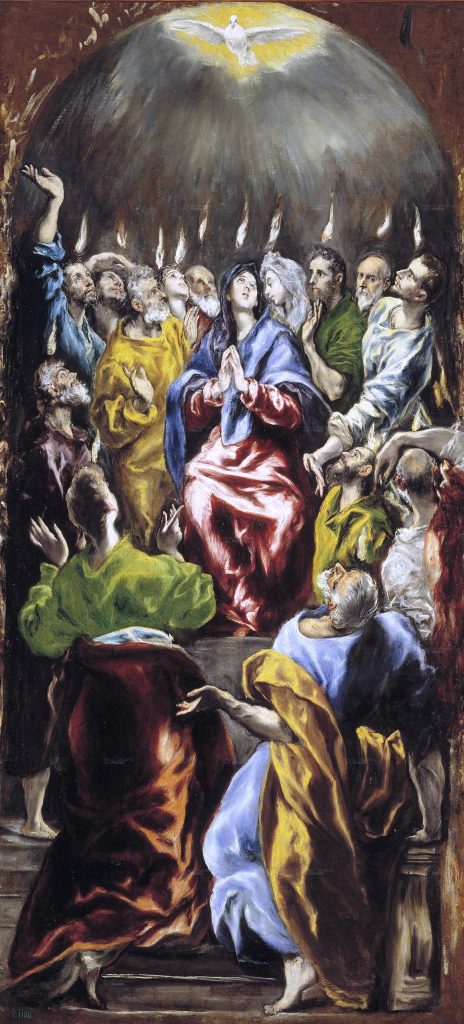
Pentecost commemorates the coming of the Holy Spirit on the new Church 50 days after the Resurrection of Christ (and 10 days after the Ascension). This year Pentecost falls on May 19; it marks the end of the Easter season.
This mirrors Jewish tradition in which Pentecost (“Shavuot” in Hebrew) is the 50th day after Passover. In fact, Mary, the Apostles, and the other disciples were together in Jerusalem to observe Jewish Pentecost when something extraordinary happened:
When the day of Pentecost came, they were all together in one place. Suddenly a sound like the blowing of a violent wind came from heaven and filled the whole house where they were sitting. They saw what seemed to be tongues of fire that separated and came to rest on each of them. All of them were filled with the Holy Spirit and began to speak in other tongues as the Spirit enabled them.
Acts 2:1-4
So, Pentecost is really the Church’s birthday! On Pentecost, the disciples were empowered by the Holy Spirit to preach the Gospel. Many people came to believe in the message of Jesus Christ, and the Church grew. The Church’s mission continues to this day.
Many parishes have picnics and festivals on Pentecost Sunday. In England, it’s called “Whitsun” because in medieval times white doves were often released at parish celebrations or white rose petals were showered on the parishioners. Intriguing!
Here are some simple ideas for celebrating Pentecost at home with your family.
The Holy Spirit
Fruits of the Holy Spirit. This is the perfect time of year to teach your kids about the fruits of the Holy Spirit. These are virtues that we can all grow in when we allow the Holy Spirit to work in us. They are very evident in holy Christians.
The fruits are charity, joy, peace, patience, kindness, goodness, long-suffering, humility, faithfulness, modesty, self-control, and chastity.
Talk as a family about these virtues.
- What do they mean?
- Which virtues are easy for you and which ones do you need to work on?
- How can we help each other tap into the power of the Holy Spirit so we can bear more fruit for Christ? (Note: You can adjust the chastity explanation so it’s appropriate for your kids. You know, don’t wear your underpants around the house when Grandma is visiting!)
Here’s a Free Fruits of the Holy Spirit game from The Catholic Toolbox! While you’re playing your game, you can snack on a 12 fruits salad! I’ve adapted this recipe from Evelyn Birge Vitz’s lovely book A Continual Feast.
12 Fruits of the Holy Spirit Salad
- 12 kinds of fruit, washed, hulled, and sliced (ideas: strawberries, blackberries, blueberries, kiwi, bananas, oranges, apples, peaches, pineapple, cantaloupe, mango, apricots)
- sugar
- lemon juice
Mix all your fruit together in a large bowl or arrange them in a pattern on a platter. Sprinkle with a little sugar and lemon juice. Alternatively, you can serve this salad with honey-yogurt dressing
Honey Yogurt Dressing
- 1 cup plain yogurt
- 2 teaspoons honey
- 1/4 teaspoon nutmeg
- 1/4 teaspoon cinnamon
- 1/4 teaspoon ginger
- 1/2 teaspoon grated lemon rind
Mix ingredients well and chill.
Novena to the Holy Spirit. Did you do a Novena to the Holy Spirit beginning on Ascension? If not, you can start one on Pentecost!
Tongues of Fire
Bonfire. This would be a great time of the year for a family bonfire. Talk about how fire works. How might this compare to the working of the Holy Spirit?
Fire streamers. How cute are these ribbon streamers? If you use red, orange, and yellow ribbons, they’ll look flame-like.
Family flame painting. This is a great idea. Make a painting together while discussing the power of the Holy Spirit.
Wall of Flames: Make 12 flames out of yellow, red, and orange construction paper. Write a different fruit of the Holy Spirit on each flame, and allow your kids to create a collage of flames on a wall in your kitchen or living room. This would be a great conversation starter throughout the summer as routines are changing and families are spending more time together (you know, more time for love, but also more time for bickering and whining!).
Alternatively, create several blank flames and place them on a tray with a marker and a roll of blue painter’s tape. When a family member notices another family member practicing one of the 12 fruits, they can write the virtue on a flame and tape it to the wall. Over the summer, your family will build a wall of flames.
Sharing the Faith
If you have pre-teens and teens, have a conversation about the challenge of being a Christian and sharing our faith in the 21st century. The disciples were given the power to talk to others in foreign languages, and honestly sometimes it feels like we’re living in a foreign land. Living the Faith can be challenging, and many cultural observers believe it will only become more difficult. Our world is becoming increasingly hostile to Christianity and the Christian values that provided a foundation for our civilization. But, as our children mature, the Holy Spirit will give them courage to stand firm in their faith while treating others with love, patience, and kindness.
Before they go off preaching the Gospel like the disciples did on Pentecost, it’s important that our kids become properly evangelized themselves, that they learn to understand what the Church really believes. I’m sure your kids are learning their Catechism. This is a good place to start. Our kids also need role models and encouragement in their faith.
Ascension Books and Media has many articles and videos that appeal to teens. Ascension Presents is a popular YouTube channel produced by Ascension. The staff tend to be young adults. A few of the shows are more appropriate for adults, but most of them are great for teens. Let your teen check out Father Mike Schmitz. Teens identify with him, and he doesn’t compromise the truth.
For more great tips on living the faith with your kids, check out my books Discipleship Parenting and Rooting Your Teen in the Faith.
Subscribe to ICP Feed
Subscribers to Intentional Catholic Parenting (“ICP”) receive all blog posts and podcasts immediately after release.
ICP subscribers do not receive newsletter content (unless they subscribe to the newsletter separately).
Time commitment: Blog posts take 3-5 minutes to read; podcasts are about 20 minutes long.
Subscribe to Newsletter
“The Anchor and Maze” explores how parents can navigate the maze of parenting while remaining a child’s emotional anchor.
Newsletter subscribers receive links to recent posts, but possibly later than blog subscribers.
Time commitment: I keep the newsletter short. It takes about 1 minute to read.

